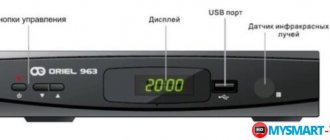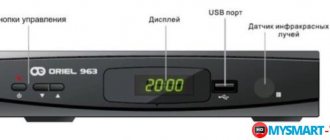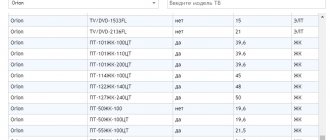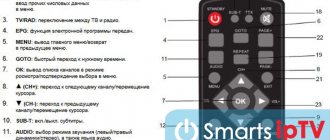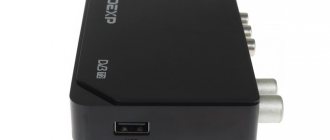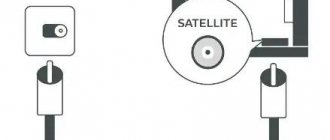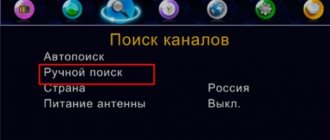How to connect an Oriel digital set-top box to your TV
The connection process itself is not complicated, especially if you follow the detailed instructions. An RCA cable is included with the receiver. But, if you have an HDMI cable, it is better to use it, because... it provides better sound and image transmission. You should also initially familiarize yourself with the console itself. The front part contains the main control keys and display:
The rear panel has built-in connectors for:
- Antennas.
- HDMI.
- SCART.
- RCA.
Connecting the device
The connection instructions are suitable for all device models, including 4030, 4150, 403d, 415d, 740, 213, 101, 314, 421ud, 963, 4210. First of all, disconnect all devices from the power supply. Then, depending on the cable used, make the connection. The diagram clearly shows the process for different connectors.
Initial settings
The second step is to make sure there are working batteries in the remote control. When you turn on the TV with the set-top box connected, a welcome window will appear on the screen where you will need:
- Specify country.
- Select language.
- Set the optimal resolution and aspect ratio.
How to connect the Selenga set-top box to a TV to receive digital channels
To save and continue the initial settings, click on “Ok”. Next, an auto search for channels will start, the list of which will be displayed on the screen. The search will be carried out according to the DVB-T2 standard.
If you have any questions or complaints, please let us know
Ask a Question
Review of DVB-T2 receiver Oriel 793. Appearance, equipment, configuration.
Good time!
Today we will learn more about the Oriel 793 digital TV set-top box.
Last year, in 2014, the absolute leader was the Oriel 790 receiver. It has proven itself well and enjoyed deserved popularity due to its reliability and stability.
And today, in 2015, it is being replaced by its updated modification Oriel 793.
The console is supplied in a snow-white box.
There is an on-air receiver of the DVB-T2 standard with signal reception on a regular decimeter antenna, a built-in HD media player that supports playback of most of the most common video formats.
It is possible to record a television signal.
Outputs include HDMI output, composite (bells) and coaxial digital audio output.
The Oriel 793 package includes: the receiver itself, a full-function remote control, two AAA pinky batteries, as well as an instruction manual combined with a warranty card. The warranty is 12 months.
Let me immediately draw your attention to the fact that there is NO HDMI cable or low-frequency cord for connecting to a TV.
Now let's get acquainted with the appearance of the console. The case is metal, the front panel is plastic. There is an indicator here that displays the time in standby mode, and during operation the channel number or operating mode of the set-top box. Also an LED indicator (lit red – the set-top box is disabled, green – enabled). And, of course, there is a USB input. As we remember, it is used to connect a flash drive or hard drive. We can record television programs on them, and also use the built-in HD media player.
On the rear panel we see an antenna input, an antenna output, a coaxial digital audio output, bells (composite low-frequency output to a TV), an HDMI output and a power cord.
Now let's connect the set-top box to the TV.
We turn on the set-top box to the network, use an HDMI cable to the TV, and also connect the antenna cable.
Now press the power button on the remote control. A small menu of presets appears on the screen.
Next, click OK and get to the main menu of Oriel 793.
The first item is – Editing channels. Since there is nothing to edit yet, the lines are dull.
The second point is Setting up channels. This is the main point that will be required to quickly set up channels.
The third point is System Installation. Here you can set the console to suit you (that is, time, language, parental controls, etc.).
The fourth point is Tools. Here you can view data about the set-top box, firmware, as well as factory settings.
Fifth point - Games. There are two well-known games here - Othello and Sudoku.
The sixth point is Recording. This is where you work with the USB port.
We return to the second point - Setting up channels. Here you can select – Automatic search. If you are confident in your antenna that it is working properly and oriented in the right direction. Then you press the OK button on the remote control, and the set-top box will scan the entire frequency range that is available to it and tune in to all channels broadcast in the DVB-T2 standard.
This is a fairly lengthy procedure.
For quick setup, go to manual search and click OK.
Here we need to select the channel numbers on which the broadcast is taking place (exactly in the place where this set-top box will work).
After selecting the channel, go to the line – Search and click OK.
Now the set-top box will quickly find those channels that are on the frequency you select.
If there are more frequencies in your region, then you again go to the item – Setting up channels, set the frequency and press – Search with the OK button on the remote control.
When you finish setting up, the OK button on the remote will bring up a list of channels on the screen.
That's all the setup.
The menu is simple and affordable. If you don't understand something, watch the video below
or follow the link https://www.youtube.com/watch?v=aTp72koHK5g.
That's all.
All the best!
Like
- < Back
- Forward >
Basic Operations
Further configuration will also be carried out using the remote control. You should familiarize yourself with all the button assignments.
Basic operations include setting up the following sections:
- Program Manager.
- Picture parameters.
- Search for broadcasts.
- Setting the time.
- System parameters.
Each item implies several categories. Any user without special knowledge can perform the setup; just follow the instructions.
Program Manager
This section allows you to edit the list of channels. It is located at the very top of the menu. Here you will find a list of broadcasts, radio channels. You can also delete an unnecessary channel or add it to your favorites.
In the broadcast list, editing is carried out as follows:
- To block a specific broadcast, press the red key on the remote control.
- To skip - green.
- To move the channel to another position - yellow.
- Rename the broadcast - blue.
- To move a channel to the list of favorites, use the FAV button.
If you plan to delete all channels at once, you will need to enter the password 1234 (default).
Image Settings
Adjust the image in the third section “System Settings” in the “TV System” tab.
Select the optimal screen resolution. It is recommended to set automatic detection, but sometimes you have to do it manually. In this case, the image resolution depends on the type of connection:
- 480r/i.
- 576i/p.
- 1080p/i.
The aspect ratio must be selected for your TV:
- 4:3 PS.
- 4:3 LB.
- 16:9.
Search channels
The “Channel Search” section is second in the main menu. The following options are available here:
- Automatic channel search. Activate the "Open Only" function to have the system search only for open channels. Leaving this option untouched will detect all broadcasts, including encrypted ones.
- Manual search. Start discovery by channel or frequency. Specify the range in which the search will be carried out - MV or UHF. Next, enter the broadcast number or frequency. Below you will notice visual information about the quality of the incoming signal and intensity.
- In the next tab, indicate the type of broadcasts to be scanned - all, free or encrypted.
- Activate the antenna power point if you are using an active device with a built-in amplifier.
Why doesn’t IPTV Player show on the computer and TV: reasons, how to fix it?
Setting the time
Time settings are located in system settings. Here it is configured:
- Shit. Select the one where you live.
- Application of GMT. By selecting the “By region” option, the system will automatically set the time. By disabling it, you can independently specify the time and time zone.
- Timer. Allows you to record broadcasts and set reminders to watch a specific broadcast.
Setting options
Edit the main menu:
- Select the demonstration time – 1-10 seconds.
- Set transparency – 0-40%.
System Settings
This section includes the following functions:
- Information about installed software.
- Parental control. When using, the system will ask for a password, enter 1234. The function allows you to lock the main menu, specify age restrictions, and change the password.
- Reset parameters to factory settings. This feature is often used to fix serious system errors.
- Software update via USB. Go to the official website of the set-top box manufacturer and download the latest software patch to a flash drive, then insert the drive into the set-top box and in this section select “Update via USB”. Wait for installation.
Oriel 793
The technical capabilities of the Oriel 793 for receiving free-to-air programs in the DVB-T-T2 format and the presence of additional practical capabilities allow the device to be classified as a middle-class receiver from the Oriel brand. The speed of command execution is ensured by the modern Ali M3812 chipset, which is successfully combined with a sensitive Sony CXD286 tuner, matched with a built-in SONY CXD2837 . Reliable reception of a weakened signal, the presence of a digital COAXIAL audio output, and a new housing design are the main differences of the model.
The quality of the projected image depends only on the technical characteristics of the TV available. The composite output provides clarity and contrast of the picture when using an analog receiver; a connection via the HDMI interface is capable of creating a picture on a digital TV screen with a resolution of up to 1920x1080 p. All radio stations operating in the frequency ranges 174-230 MHz, 470-862 MHz can be received by the tuner of the set-top box for listening.
The built-in USB 2.0 connector serves all possible connections of external memory media (hard drives, flash memory). The result of the connection is the activation of the functions:
- Playback of previously recorded media format files specified by the manufacturer.
- Removing factory settings, installing more modern software.
- Quickly search for the fragment required for playback, briefly stop playback and return to the beginning of viewing (Time Shift).
- Copying broadcast programs in current time mode, with the introduction of time intervals using a recording timer (PVR).
The package does not include connection cords. The set includes an Oriel 793 receiver, a remote control with AAA elements, an instruction manual, and a warranty. The design of the device is a combination of a rectangular iron body and a plastic front panel. The design of the panel is made in a classic style, without aesthetic frills. The front panel is equipped with a device logo, a 4-character green display, an IR signal sensor, an operation indicator and a USB port.
The rear panel has an antenna input/output socket (RF IN, RF OUT), an HDMI interface, a coaxial digital audio output (COAXIAL), a composite output socket (CVBS), stereo audio output connectors (L, R), and a voltage cord input point for the indoor unit. nutrition. The top, bottom and side panels have vents to improve passive ventilation.
Technical features of Oriel 793
- Teletext, subtitles, parental controls.
- Electronic editor for the list of EPG channels.
- Manual, automatic search for broadcast channels.
- Dimensions: 188 x 159 x 60 mm.
When analyzing the operation of the Oriel 793, attention is drawn to the good picture quality, reliable file playback, and the presence of a digital audio output and antenna output. The disadvantage is the lack of command buttons on the case, the AC-3 audio codec, and the delay when switching channels.
How to set up the Oriel console without a remote control
The first step is to connect the Oriel set-top box to the TV, as indicated at the beginning of the article. If you cannot use the remote control, you will have to make settings using the control buttons on the set-top box itself. The front panel has all the required keys.
Due to the absence of most control buttons, you will not be able to use many options. For example, adding a channel to favorites and setting up the list will be problematic. Also, functions that require a password will not be available. But, running channel detection and adjusting the image is not difficult.
Possible problems and their solutions
Sometimes users encounter unexpected problems while using the Oriel set-top box. Often the reason is hidden in a system failure. Most problems can be fixed on your own, but if they happen constantly, then it is better to go to a service center.
Oriel box does not find channels
If the set-top box refuses to detect TV broadcasts, check for updates. Remember that any system requires regular updates. Go to the official website of the developer and check the latest patches in the appropriate section. Download the file to a flash drive, insert it into the set-top box, go to the menu and select “Update via USB”.
If the error persists, try resetting the settings. The function is located in the “System and TV” category. After the procedure, all information will be deleted and settings will be reset.
Does not respond to the remote control or the button does not work
Initially, make sure that the reason is not due to dead batteries. The second reason is the long distance, that is, you are trying to use the remote control while being too far from the console. Are you doing everything right? It may be time to replace the remote control with a new one or send it in for repair.
No signal
The lack of a signal is often due to technical work by the provider. Call the hotline and clarify the question; maintenance work is probably underway and therefore the broadcasts are unavailable. Also, the reason may be due to unfavorable weather or a damaged cable.
